
Hypermnestra
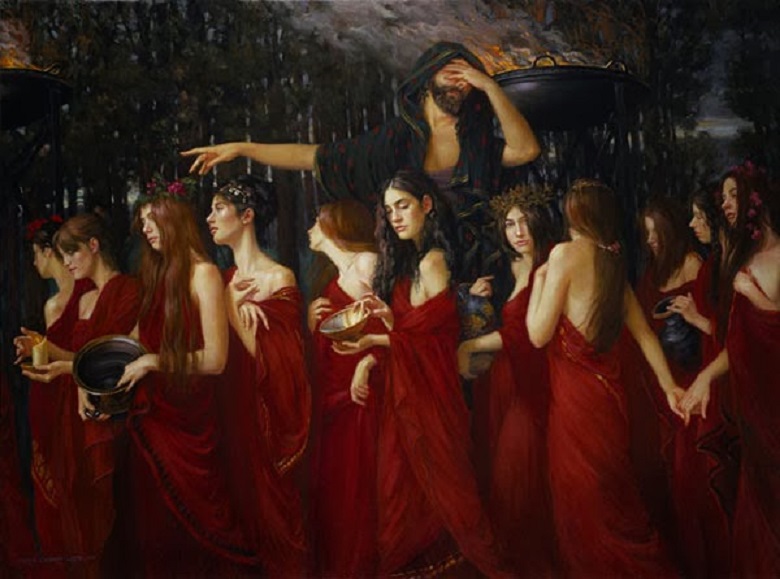
The Short Version:
Hypermnestra was the daughter of Danaus in Greek mythological character. Danaus was the twin brother of Aegyptus and son of Belus. He had fifty daughters, the Danaides, and Aegyptus had fifty sons.
Aegyptus commanded that his sons marry the Danaides and Danaus fled to Argos, ruled by King Pelasgus. When Aegyptus and his sons arrived to take the Danaides, Danaus gave them to spare the Argives the pain of a battle.
However, he instructed his daughters to kill their husbands on their wedding night. Forty-nine followed through, but one, Hypermnestra refused because her husband, Lynceus, honored her wish to remain a virgin. Danaus was angry with his disobedient daughter and threw her to the Argive courts. Aphrodite intervened and saved her.
Lynceus later killed Danaus as revenge for the death of his brothers. Lynceus and Hypermnestra then began a dynasty of Argive kings (the Danaan Dynasty), beginning with Abas. In some versions of the legend, the Danaides were punished in the underworld by being forced to carry water through a jug with holes, or a sieve, so the water always leaked out. Hypermnestra, however, went straight to Elysium.
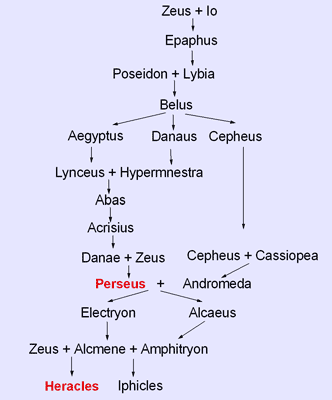
Hypermnestra is also the daughter of Thestios and Eurythemis. Her sisters are Althaia and Leda. With her husband Oikles she had a son namend Amphiareos, who later took part in the war of the Seven Against Thebes.
[1]
The Long Version:
Hypermnestra was the eldest of the 50 daughters of Danaus and the only daughter not to murder her husband on her wedding night. Aeschylus wrote a drama The Suppliants which tells part of the story. Danaus was succeeded by 21 kings of Argos before Diomedes left for the Trojan War. So the details of the story are set several hundred years before the Trojan War. The Minoan culture and not the Mycenean culture would have been dominant at that time.
The story of Hypermnestra begins with the Myth of Io. Io was the very first priestess of Hera at Argo and the daughter of the founder of the cult. She was such a lovely priestess that Zeus fell in love with her. To avoid detetion by Hera he changed her into a white cow. But Hera put the hundred eyed Argus to watch Io. When Hermes killed Argus Hera sent a gadfly to pester Io. The gadfly caused her to wander and she eventually arrived at the Nile river. There she bore Epaphus and founded the worship of Isis. Her wanders suggested the phases of the moon and she was regarded by many as a moon goddess. Epaphus was the ancestor of Danaus who was the father of Hypermnestra in Egypt.
What the myth of Io means is not clear but the Mycenaeans did have contact with Egypt. The Hyksos were an Asian group related to the Canaanites that invaded Egypt. Later the “Sea Peoples” attacked Egypt. The Sea Peoples could have been Mycenaeans that were called Philistines by the local people. The Philistines occupied the five cities of Gaza , Ashkelon , Ashdod , Ekron , and Gath, along the coastal strip of southwestern Canaan, that belonged to Egypt up to the closing days of the Nineteenth Dynasty_of_Egypt> (ended 1185 BCE -1180s_BCE>). Io’s cow nature seems like it might be related to the worship of Baal by the Canaanites. Isis and Hera are related because they are both wives of main gods and have a relation to wives and mothers. The cow nature of Isis may be related to the horns of the cow. At any rate the travels of Io explain why Hypermnestra was born in Egypt. Yet the identification of Hypermnestra with Egypt is not certain. She could be related to another Mid-east culture such as Hatti or Hurrian Culture. When the King confronts the suppliants in the play of Aeschylus he describes their clothing as rich Eastern robes. He also guesses several countries: Libyia, Egypt, Cyprus, and Indian in Ethiopia. But, he says, with bows, they would be most like Amazons. Unfortunately there are no Archeological remains found for the Amazons.
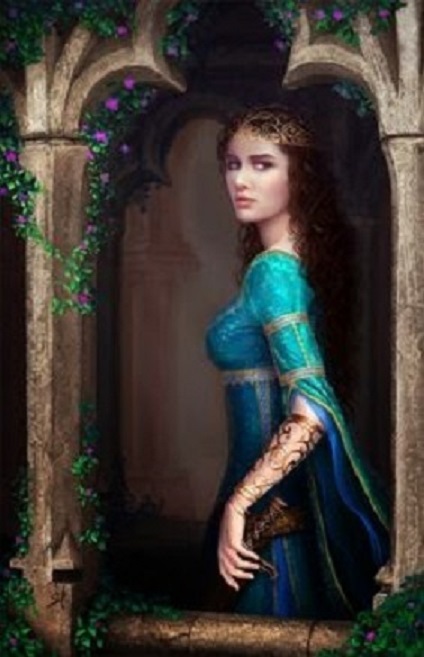
Hypermnestra was born in Egypt, one of the fifty daughters of Danaus. Her mother was Elephantis. This name probably relates to her being ivory skinned rather than other elephant properties. The story goes that Danaus fled Egypt because he thought his brother wanted to kill his 50 daughters. His brother Aegyptus had 50 sons who claimed the daughters in marriage for what Danaus felt were evil purposes. So he built a ship and fled Egypt with his daughters. It is said that he built the first sailing ship since his daughters could not have been expected to row.
This story may be a merger of cosmic and historic facts. The name Aegyptus relates well to Egypt but may actually point to another mid-east area. The name Danaus may relate to Danae but it also seems to describe Dorians. The language of Greece reflects an Indo-European background but it is not clear where the Indo-European ancestors were from. The name Caucasian suggests the region of the Caucasian Mountains rather than Egypt but it does relate to the fact that the people were ivory skinned. The number 50 relates to the reconciliation of the lunar year and the solar year. Rather than Egypt the expusion may relate to an expulsion similar to the expulsion of Adam and Eve out of the Garden of Eden. The sin of sex may be the cause of both the desire of marriage and the desire of punishment with death for the daughters. This death is not a real death but the initiation of sex that has the maiden die with the birth of a child and the mother now able to care for the baby. This initiation is related to the moon because the lunar month is closely related to the menstrual cycle in women. That Hypermnestra ultimately becomes the founder of the Greek race relates both to the reconciliation of the lunar year and the solar year and the reconciliation of Lynceaus and Hypermnestra to the realities of marriage. So the Myth describes the arrival of a new race not from Egypt but from some other Mideastern area better named Eden. Perhaps Danaus would be better named Edenaus. The conflict between the two brothers represents a conflict between and old world of perfection called Egypt or Eden and a new world of reality in Achea.
Wood was important to Danaus for two reasons: Apollodorus states that Danaus was the first to build a ship of wood while Pausanus states that the Danaus was the first to set up images of the deities and these were of wood. This may relate to the problem of Xoan. The statues that Danaus and Hypermnestra set up in appreciation of the acts of deities are of wood. Pausanias says that all early images of deities were of wood. Wood relates to trees and trees are permanent representatives of the nature that provides sustenance and material well being. Also in the pieces of wood there may be images that are reminisent of important beings and things. These images suggest the deities that are worshipped. In addition little is more indicative of the power of a deity than a lightning stroke. When one hits a tree suggestive fragments can be produced that are reminders of the deities. It would be an easy nest step to enhance these features with carving. From this statues of the deities may have resulted.
The first ships in Egypt were made of reed. Wooden ones followed. How sails were discovered is not known but reeds may have been the first sails as well. Weaving began with baskets. The first sails may have been woven of reed like baskets. Weaving is often associated with women but the first weaving of cloth could have been associated with sails. What is certain is that the ship of Danaus was made of wood and it had sails. I line 133 of ‘the Suppliants’ Aeschylus references this fact. It would have been too much to expect the daughters to have rowed. Danaus made his getaway but it was not long before he was followed but this time it was a ship with men. The sails may have made the getaway easy but they also may have made his ship so remarkable that it was easy to follow. But the ship that followed him needed no sails.
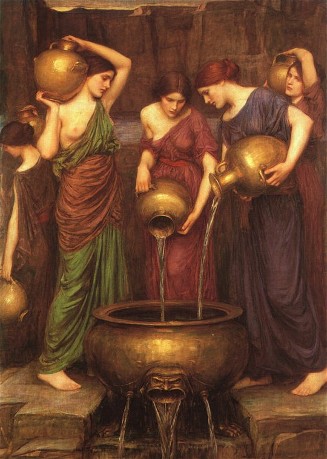
The story of Hypermnestra up until she arrived in Argos is somewhat sketchy. But the play Suppliants by Aeschylus provides a lot of detail after that. This is believed to be the first of three plays in a trilogy about Hypermnestra. It was for a while thought to be the oldest existing play but it is now thought to be later than the oldest by some 20 years. The other two plays in the trilogy are lost. This play is interesting because of its emphasis on divine verses mortal law. The sons of Aegyptus justify their marriage to the daughters of Danaus by reference to Egyptian law. The daughters justify their actions by reference to divine law. A substantial part of the drama involves prayers to divinities to allow the daughters to pursue their claim. This gives insight into the nature of their beliefs. There is also some indication of how the local government works. The King appeals to a council of citizens who vote on the claims of the daughters for protection. They are won over by an appeal to divine law by the King. At the end of the first play the people of Argos have agreed to protect the daughters from the claims of the sons of Aegyptus.
For some reason the King of Argos was deposed and Danaus took over. The sons of Aegyptus were able to press their claims so a marriage was arranged. Danaus agreed to it but he compelled each daughter to kill her husband on her wedding night. He also passed a law that punished any daughter that disobeyed. All but Hypermnestra obeyed. She fell in love with her betrothed and could not kill him. Not only did she spare him but she helped him to escape to another city. They even arranged a signal so she would know that he arrived safely. For many years the people of Argos celebrated a festival of torches to remember this event which ends the second drama of the trilogy.
The daughter that spared her husband was convicted of a capital crime. The other daughters had committed murder. This was a pollution that made them less valuable to other husbands. Pausanius said that to overcome this problem Danaus held a footrace for elligible men. The winner of the footrace was able to pick the most beautiful daughter as a bride. He also did not require the husband to provide a bride-gift in exchange for the bride. But she never got rid of the pollution. Some say Lynceus eventually killed the daughters but this seems unlikely if he was to get along with his wife hypermnestra. But when they finally did die and go to Hades Persephone punished them. They were required to carry water to fill up a basin. But the jars they were given were like seives and leaked out all the water between the fountain house and the basin. They are popular art subjects carrying their leaky seives to the basin.
The third Drama of the trilogy relates to the trial of Hypermnestra for disobeying her father’s instruction to kill her husband.
Of the third drama of the trilogy of Hypermnestra one fragment from the address of Aphrodite has been preserved:
“Longs the pure sky to blend with Earth, and Love
Doth Earth impel to yield to his embrace;
The rain shower, falling from the slumberous heaven,
Kisses the Earth; and Earth brings forth for mortals
Pasture for sheep-flocks and Demeter’s grain.
The woods in spring their dewy nuptials hold;
And of all these I am in part the cause.”
Apollodorus lists the daughters of Danaus and who they married.
Hymnestra, the eldest, daughter of Elephantis, married Lynceus the son of Argyphia, a woman of noble blood.
Gogophone, daughter of Elephantis, married Proteus the son of Argyphia, a woman of noble blood.
Automate, daughter of Europe, a queen, married Busir.
Amymone, daughter of Europe married Enceladus.
Agaved, daughter of Europe married Lycus.
Scaea, daughter of Europe married Daiphron.
Hippodamia, daugher of Atlantia or Phoebe, Hamadryad nymphs, married Istrus, son of an Arabian woman
Rhodia, daugher of Atlantia or Phoebe, Hamadryad nymphs, married Chalcodon, son of an Arabian woman
Cleopatra, daugher of Atlantia or Phoebe, Hamadryad nymphs, married Agenor, son of an Arabian woman
Asteria, daugher of Atlantia or Phoebe, Hamadryad nymphs, married Chaetus, son of an Arabian woman
Hippodamia, daugher of Atlantia or Phoebe, Hamadryad nymphs, married Diocorystes, son of an Arabian woman
Glauce, daugher of Atlantia or Phoebe, Hamadryad nymphs, married Alces, son of an Arabian woman
Hippomedusa, daugher of Atlantia or Phoebe, Hamadryad nymphs, married Alsmenor, son of an Arabian woman
Gorge, daugher of Atlantia or Phoebe, Hamadryad nymphs, married Hippothous, son of an Arabian woman
Iphimedusa, daugher of Atlantia or Phoebe, Hamadryad nymphs, married Euchenor, son of an Arabian woman
Rhode, daugher of Atlantia or Phoebe, Hamadryad nymphs, married Hippolytus, son of an Arabian woman
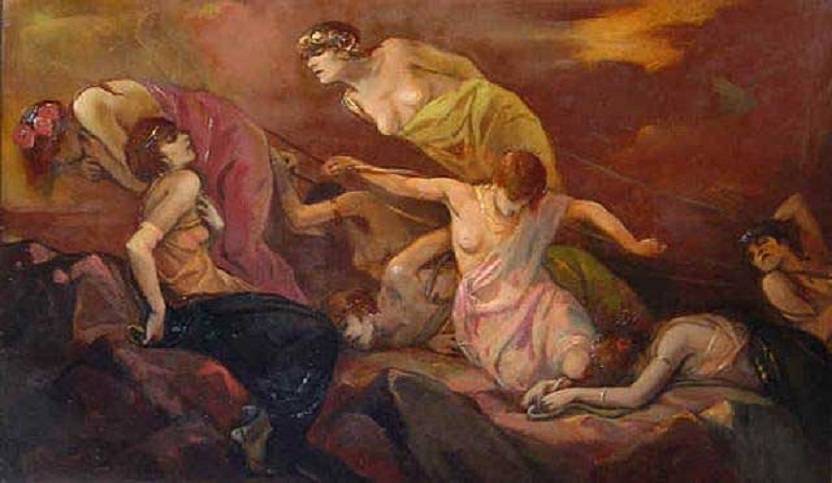
Evidently Hypernestra fell in love with her husband. In the first drama divine law must be used to overcome the Egyptian law that allows the cousins to demand the daughters of Danaus. In the last drama divine law must be used to overcome the demand that Hypermnestra be put to death because she disobeyed the law that Danaus made to overcome the results of the demands of the cousins. Aeschylus opposes divine and mortal law on both sides. Obviously the point of the trilogy relates to this interaction.
The Danaides were condemned to carry water forever in the underworld because of their role in the murder of their husbands.
[2]
Sources
[1] "Hellenica World"
[2] "The Role of Women in the Art of Ancient Greece"
Our Mobile Application
Check out Our Mobile Application "Ancient Greece Reloaded"


